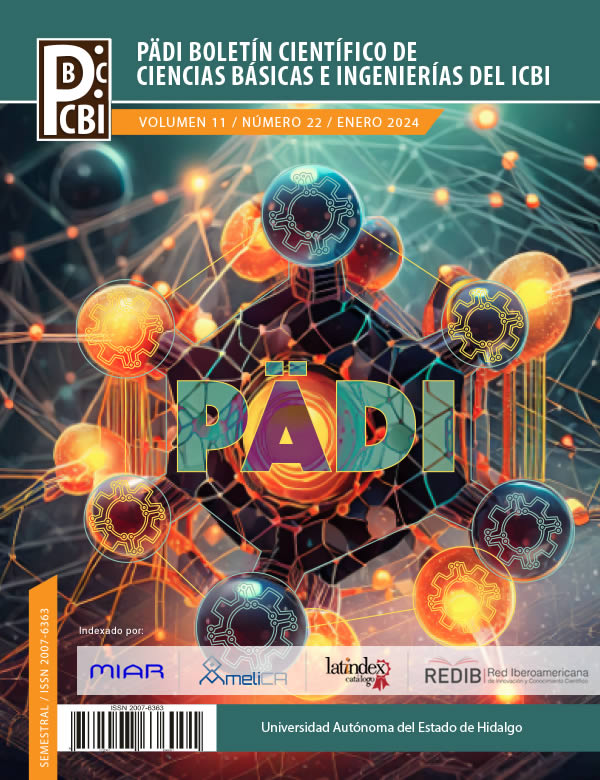Micrometric-sized Boehmite obtained from urban waste
Abstract
In this work, the production of aluminum hydroxide by leaching aluminum scrap in an alkaline NaOH solution was investigated. Two precipitations were carried out at different pH values. In the first precipitation, the impurities of the aluminum scrap were separated; in the second precipitation, micron-sized aluminum hydroxide particles were obtained. Chemical equilibrium diagrams were shown to be useful in explaining the formation of different chemical species during aluminum scrap treatment, including solid, ionic, and aqueous chemical species. The solid chemical species, mostly impurities, were separated by filtration, while the ionic and aqueous ones were used to produce an aluminum hydroxide solution. Micron-sized aluminum hydroxide particles were obtained by neutralizing the solution, followed by separation and drying. The specific surface of the powders was 69.83 m2/g, results consistent with the results of the crystallographic analysis. These results suggest that this process could be an efficient way to produce micron-sized aluminum hydroxide particles from urban waste.
Downloads
References
Ahmad, R., Anwar, M. S., Kim, J., Song, I. H., Abbas, S. Z., Ali, S. A., Ali, F., Ahmad, J., Awais, H. B., Mehmood, M. (2016). Porosity features and gas permeability analysis of bi-modal porous alumina and mullite for filtration applications. Ceramics International 42, 18711-18717. DOI:http://dx.doi.org/10.1016/j.ceramint.2016.09.009
Asencios, Y. J., Sun-Kou, M. R. (2012). Synthesis of high-surface-area γ-Al2O3 from aluminum scrap and its use for the adsorption of metals: Pb (II), Cd (II) and Zn (II). Applied Surface Science 258, 10002-10011. DOI:http://dx.doi.org/10.1016/j.apsusc.2012.06.063
Chen, Y., Nakazawa, Y., Matsui, Y., Shirasaki, N., Matsushita, T. (2020). Sulfate ion in raw water affects performance of high-basicity PACl coagulants produced by Al (OH)3 dissolution and base-titration: Removal of SPAC particles by coagulation-flocculation, sedimentation, and sand filtration. Water research 183, 116093. DOI:https://doi.org/10.1016/j.watres.2020.116093
Chen, Y., Wang, N., Ola, O., Xia, Y., Zhu, Y. (2021). Porous ceramics: Light in weight but heavy in energy and environment technologies. Materials Science and Engineering: R: Reports 143, 100589. DOI:https://doi.org/10.1016/j.mser.2020.100589
Cho, B. R., Kang, J. B. (2004). Synthesis of porous mullite by vapor phase reaction. In Materials Science Forum, Trans Tech Publications Ltd 449, 209-212. doi:10.4028/www.scientific.net/MSF.449-452.209
Das, B. R., Dash, B., Tripathy, B. C., Bhattacharya, I. N., Das, S. C. (2007). Production of η-alumina from waste aluminium dross. Minerals engineering 20, 252-258. DOI:https://doi.org/10.1016/j.mineng.2006.09.002
David, E., Kopac, J. (2013). Aluminum recovery as a product with high added value using aluminum hazardous waste. Journal of hazardous materials261, 316-324. DOI:http://dx.doi.org/10.1016/j.jhazmat.2013.07.042
Davis, J. R. (1993). Aluminum and aluminum alloys. ASM international. USA.
Fortier, S. M., Nassar, N. T., Lederer, G. W., Brainard, J., Gambogi, J., McCullough, E. A. (2018). Draft Critical Mineral List: Summary of Methodology and Background Information; US Geological Survey Technical Input Document in Response to Secretarial Order No. 3359. US Geological Survey. USA
Grimaud, G., Perry, N., Laratte, B. (2016). Life cycle assessment of aluminium recycling process: case of shredder cables. Procedia Cirp 48, 212-218. DOI:https://doi.org/10.1016/j.procir.2016.03.097
Hiraki, T., Takeuchi, M., Hisa, M., Akiyama, T. (2005). Hydrogen production from waste aluminum at different temperatures, with LCA. Materials transactions 46, 1052-1057. DOI:https://doi.org/10.2320/matertrans.46.1052
Hiraki, T., Yamauchi, S., Iida, M., Uesugi, H., Akiyama, T. (2007). Process for recycling waste aluminum with generation of high-pressure hydrogen. Environmental science & technology 41, 4454-4457. DOI:https://doi.org/10.1021/es062883l
Huang, S., Hu, M., Li, D., Wang, L., Zhang, C., Li, K., He, Q. (2020). Fluoride sorption from aqueous solution using Al (OH)3-modified hydroxyapatite nanosheet. Fuel 279, 118486. DOI:https://doi.org/10.1016/j.fuel.2020.118486
Li, J., Li, M., Zhang, D., Gao, K., Xu, W., Wang, H., Geng, J., Huang, L. (2020). Clean production technology of Baiyun Obo rare earth concentrate decomposed by Al (OH)3-NaOH. Chemical Engineering Journal 382, 122790. DOI:https://doi.org/10.1016/j.cej.2019.122790
Liu, W., Yang, J., Xiao, B. (2009). Review on treatment and utilization of bauxite residues in China. International Journal of Mineral Processing 93, 220-231. DOI:https://doi.org/10.1016/j.minpro.2009.08.005
Meshram, A., Singh, K. K. (2018). Recovery of valuable products from hazardous aluminum dross: A review. Resources, Conservation and Recycling 130, 95-108. DOI:https://doi.org/10.1016/j.resconrec.2017.11.026
Meyer, F. M. (2004). Availability of bauxite reserves. Natural Resources Research 13, 161-172.
Padamata, S. K., Yasinskiy, A., & Polyakov, P. (2021). A review of secondary aluminum production and its byproducts. JOM, 73, 2603-2614.
DOI: https://doi.org/10.1007/s11837-021-04802-y
Prabu, S., Wang, H. W. (2021). Improved hydrogen generation from Al/water reaction using different synthesized Al (OH)3 catalyst crystalline phases. International Journal of Energy Research 45, 9518-9529. DOI:https://doi.org/10.1002/er.6478
Prosser, M., Johnson, M., Saptaji, K. (2017). Sustainable Bauxite Mining Guidelines. Journal of Malaysian Critical Metals 2, 1-4. DOI:http://doi.org/10.15282/MyCM.v2.2017
Puigdomenech, I. (2018). Medusa, Hydra and Input-Sed-Predom. Royal Institute of Technology Se-100 44, Stockholm, Sweden.
Shi, Y., Jiang, K. X., Zhang, T. A., Guo, J. H., Zhao, A. C. (2020). Clean production of porous -Al (OH)3 from fly ash. Journal of hazardous materials 393, 122371. DOI:https://doi.org/10.1016/j.jhazmat.2020.122371
Springer, C. (2018). Assessing energy intensity and retrofit opportunities for the aluminum industry: Lessons from Vietnam. Resources, Conservation and Recycling 131, 235-246. DOI:https://doi.org/10.1016/j.resconrec.2017.12.020
Trejo-Trejo, L., Zurita-Álvarez, M. del C., Legorreta-García, F., Pérez-González, N. K., & Díaz-Guzmán, D. (2021). Obtención de α-Al2O3 a partir de escoria de aluminio. Pädi Boletín Científico De Ciencias Básicas E Ingenierías Del ICBI 9, 82-85. DOI:https://doi.org/10.29057/icbi.v9iEspecial2.7998
World Aluminum. (2023). London: “World Aluminum”, International Aluminum Institute, London, accessed feb. 2023.
Xiao, Y., Reuter, M. A. (nov. 2002). Recycling of distributed aluminium turning scrap. Minerals Engineering 15, 963–970. DOI:https://doi.org/10.1016/S0892-6875(02)00137-1
Zhang, M., Zhang, R., Xi, G., Liu, Y., Qian, Y. (2006). From Sheets to Fibers: A Novel Approach to γ-AlOOH and γ-Al2O3 1D Nanostructures. Journal of Nanoscience and Nanotechnology 6,1437-1440. DOI:https://doi.org/10.1166/jnn.2006.198
Zhou, B., Yang, Y., Reuter, M. A., Boin, U. M. J. (2006). Modelling of aluminium scrap melting in a rotary furnace. Minerals Engineering 19, 299-308. DOI:https://doi.org/10.1016/j.mineng.2005.07.017
Copyright (c) 2024 Luz Elena Ibarra-Cruz, Felipe Legorreta-García , Julio Cesar Juárez-Tapia, José Ángel Cobos-Murcia, Yaneth Rosario-Olguin

This work is licensed under a Creative Commons Attribution-NonCommercial-NoDerivatives 4.0 International License.













